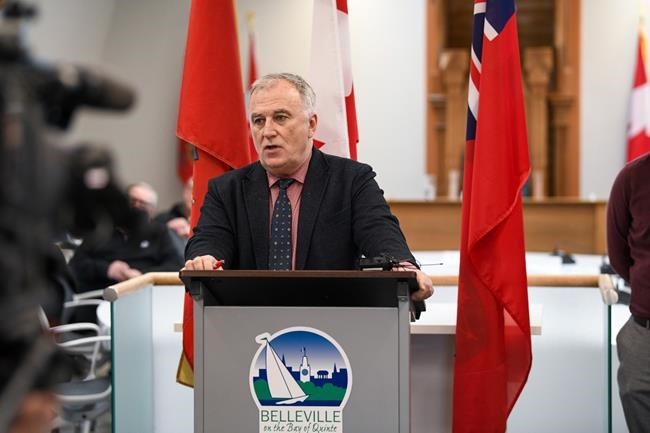The southeastern Ontario city of Belleville has declared a state of emergency after a rash of overdoses over a 24-hour period that officials say highlight how the increasing use of opioids and other drugs affects smaller communities.
Belleville Mayor Neil Ellis said Thursday the declaration was made because of the city's growing addiction, mental health and homelessness crisis and its immense strain on local emergency services.
"We, as a city, know that we are at the point where doing our best doesn’t cut it anymore," Ellis wrote in a statement.
"Our emergency services, health care system and municipal resources are being stretched to the very limits and we are close to a breaking point. We need serious action and support from senior level government to deal with this crisis and until we begin to see meaningful discussions on how to address the matter, I fear nothing will change."
Ellis said the emergency declaration acts as a request for help from provincial and federal governments. It falls under the Emergency Management and Civil Protection Act, which defines an emergency as a pending or existing situation that could result in serious harm to people or substantial damage to property, he added.
The municipality of about 55,000 residents has said that its emergency crews responded to 17 overdoses in 24 hours earlier this week. No related deaths were reported, but local police urged residents to stay away from the downtown core on Tuesday during the surge in ambulance traffic.
"On Tuesday afternoon, within a 2.5 hour timeframe, we responded to 13 opioid related calls and 9 patients were transported to hospital on a high priority," Hastings-Quinte Paramedic Services Chief Carl Bowker said in an email on Thursday.
To put that in context, he said the region's paramedics cover a 200-kilometre area and at peak capacity they have 14 ambulances on the road, with six stationed in Belleville.
"When you consider that paramedics are also responding to other medical emergencies occurring within the community at this time, these surges overwhelm our capacity to respond and lead to longer wait times," he said.
Bowker said paramedics respond to a variety of overdoses on a daily basis, which can involve alcohol, prescription medications and street drugs, but they have been making an effort to track opioid-related events "that at a minimum represent 1-2 calls per day."
"Since the beginning of the month, we have transported 45 people to hospital with suspected opioid overdoses," he said.
Hannah Jensen, a spokesperson for Ontario Health Minister Sylvia Jones, said the ministry is working with the Hastings Prince Edward Public Health Unit "to respond to the overdoses caused by a laced drug in the region."
Jensen also said in an email statement that the public health unit has received a new shipment of naloxone, which can reverse opioid overdoses, and confirmed that it has a sufficient supply.
"We are also prioritizing limiting the spread of the contaminated substance. The CMOH (Chief Medical Officer of Health) is working with Ontario's 34 public health units to ensure all regions have a plan and the necessary resources to respond should this laced drug get into other communities," the statement said.
A spokesperson for the Hastings Prince Edward health unit said a laced drug was flagged in a Feb. 2 memo to groups that provide services to people who use drugs, but local officials have no way of knowing if the same unregulated drug supply is connected to Tuesday's overdoses.
Bowker said paramedics believe the drugs that sparked the quick succession of overdose calls on Tuesday afternoon "were likely laced with a powerful sedative" because naloxone was not effective at fully reversing the symptoms.
An online dashboard that displays data from Hastings Prince Edward Public Health – which includes Belleville, Bancroft, Picton and Trenton – shows that Hastings-Quinte Paramedic Services responded to 371 opioid-related calls in 2023.
There were 252 emergency department visits related to opioid poisonings in that time period, and 50 suspected drug-related deaths.
Data from Public Health Ontario that was last updated in June 2023 shows that opioid-related ER visits occurred at a rate of 245 per 100,000 population in the area covered by Hastings Prince Edward Public Health. Meanwhile, the provincial rate was 94 per 100,000 population.
Dr. Ethan Toumishey, medical officer of health and CEO of Hastings Prince Edward Public Health, has said that Tuesday's overdose emergency is part of a larger trend in the area and across the province.
Smaller cities like Belleville need more resources and community partnerships to deal with such emergencies, he said, and also need to work on long-term solutions to the addiction crisis.
This report by The Canadian Press was first published Feb. 8, 2024.
Sonja Puzic, The Canadian Press

